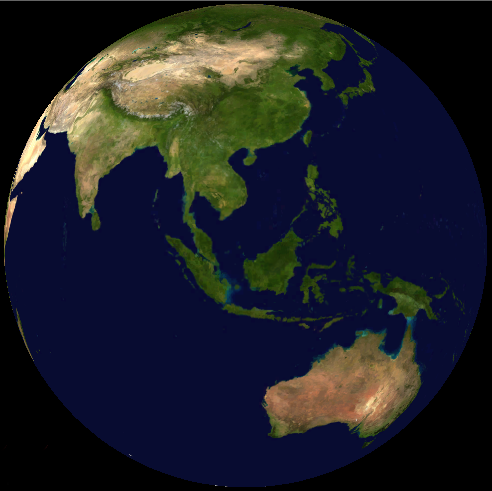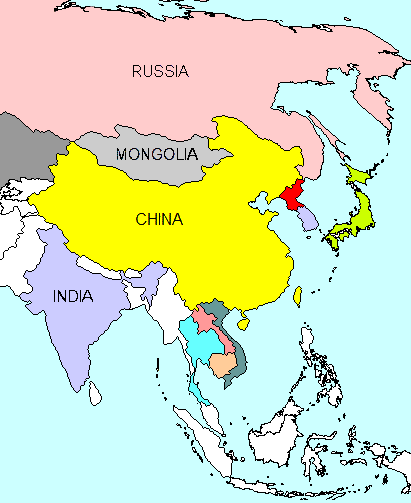Geography Pages
The Far East after World War II
All boundaries, and borders of countries, are approximate.
Some borders are disputed.
Images in the text are linked to larger images - click on them to see the larger pictures.
Hover the mouse over the images to see their captions.
Brown and blue maps are from the CIA.
![]() Go here for the History of the period.
Go here for the History of the period.
![]()
Before WW II many parts of Asia were under the control of other countries.
India, Burma, Singapore and Hong Kong were British colonies.
Vietnam and Laos were part of French Indo-China.
According to the CIA World Factbook, Thailand (formerly Siam) is the only South-East Asian country never to have been colonized by a European power.
Japan
 The Russo-Japanese War of 1904-1905 resulted in Japan taking control of parts of Manchuria, China, and Korea.
The Russo-Japanese War of 1904-1905 resulted in Japan taking control of parts of Manchuria, China, and Korea.
In 1910 Japan took complete control of Korea.
In 1914 Japan joined the Allies in WW I, and seized German colonies in Asia and the Pacific.
In 1917 the Tsarist rule in Russia fell to the Bolsheviks, and Japan took the opportunity to invade Siberia, though had to withdraw in 1922.
In 1931 the Japanese invaded Manchuria in northern China, claiming that they were liberating the Manchus from the Chinese, and set up a puppet 'empire' under the last Manchu Emperor of China, Puyi.
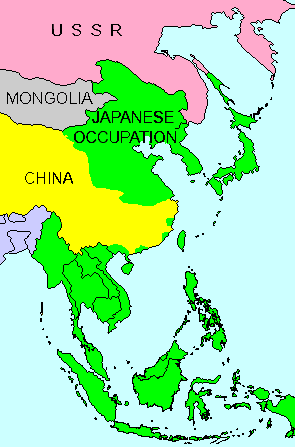 In 1936 Japan set up a puppet state in Inner Mongolia (the part of Mongolia within the Chinese territory).
In 1936 Japan set up a puppet state in Inner Mongolia (the part of Mongolia within the Chinese territory).
In 1937 Japan invaded China again and started the Second Sino-Japanese War, between Japan, the Communists under Mao Zedong, and the Chinese Nationalists under Chiang Kai-shek. They were still at war when WW II began.
Japan entered WW II in 1941 by attacking the US fleet at Pearl Harbor in Hawaii, and then attacking US forces in the Philippines and Guam, and by attacking the British forces in Malaya, Singapore, and Hong Kong. Japan went on to attack and occupy French Indo-China, Burma, Borneo, the Malay peninsular, and many of the islands in the South Pacific.
After WW II all Japanese-occupied territory was taken out of Japanese control and divided between the Allies.
Korea

 Before WW II the whole of Korea was under Japanese dominion. After WW II, the Allies took Korea under protection; the USSR took the north; the USA and other powers took the south. In 1948 attempts to re-unite Korea failed; the USSR set up the communist "Democratic Peoples' Republic of North Korea", with Kim Il-sung as Premier; the USA and other powers set up the "Republic of Korea" in the south.
Before WW II the whole of Korea was under Japanese dominion. After WW II, the Allies took Korea under protection; the USSR took the north; the USA and other powers took the south. In 1948 attempts to re-unite Korea failed; the USSR set up the communist "Democratic Peoples' Republic of North Korea", with Kim Il-sung as Premier; the USA and other powers set up the "Republic of Korea" in the south.In 1950 Kim Il-sung started the Korean War by invading South Korea. Although a cease-fire was agreed upon in 1953, the two countries are still technically at war.
China

 China was ruled by the Qing dynasty of Manchuria for 268 years, from 1644 to 1912. Towards the end of the Qing dynasty China suffered famines, floods, droughts, starvation, rebellions, revolts, governmental corruption, military defeats, the loss of territory to foreign powers, child emperors, and increasing political instability.
China was ruled by the Qing dynasty of Manchuria for 268 years, from 1644 to 1912. Towards the end of the Qing dynasty China suffered famines, floods, droughts, starvation, rebellions, revolts, governmental corruption, military defeats, the loss of territory to foreign powers, child emperors, and increasing political instability.
In 1911 the Wuchang Uprising led to the Chinese Revolution and the creation of the 'Republic of China'. The five-year-old Emperor Puyi was forced to abdicate in 1912, and a period of anarchy ensued. The Revolution had been led by the Kuomintang (KMT) - the Chinese Nationalist Party, under the leadership of Dr. Sun Yat-sen, who became for a brief time the first President of the Republic of China. China continued to be torn by civil wars, particularly in the north, where several war lords tried to set up their own territories.
In 1919 Sun Yat-sen re-established the KMT. Sun Yat-sen was a medical doctor, who became a Christian and tried to combine his Christian ideals with the revolutionary movement.
In 1921 the Chinese Communist Party (CPC) was founded by students and intellectuals who were influenced by Marxism. Mao Zedong was a founding member, and became one of the leaders.
In 1921 the KMT, led by Sun Yat-sen, came to an agreement with the CPC and set up a rival government in the southern city of Guangzhou. Sun Yat-sen died in 1925 and General Chiang Kai-shek became leader of the KMT. Chiang Kai-shek led a military campaign and overthrew the northern government, then set up the Chinese Nationalist government in 1928. However, in 1927 Chiang Kai-shek had massacred Chinese communists in Shanghai, so the CPC rebelled and started the Chinese Civil War.
In 1931 Japan invaded Manchuria and set up the puppet state of Manchukuo under Emperor Puyi in 1932.
In 1937, Japan invaded northern China, and a three-sided war ensued between the KMT, the CPC, and Japanese forces in China. The war was still being fought when WW II began.
In 1945, after the surrender of Japan at the end of WW II, fighting between the KMT and the CPC resumed. 1946 is reckoned as the start of the Chinese Communist Revolution.
In 1947 the Republic of China was re-established, but in 1949 Mao Zedong and the Red Army of the CPC overthrew the Nationalist government on mainland China and founded the People's Republic of China with its capital in Beijing.
Chiang Kai-shek and the KMT fled to Taiwan and set up Taipei as the capital of the Nationalist government. Generalissimo Chiang Kai-shek ruled Taiwan as 'President of the Republic of China' and 'General of the Kuomintang' until his death in 1975. He had been a major leader with the Allies in WW II, and helped to unify China, but he also acted as a dictator and autocrat who assassinated his opponents.
Mao Zedong was Chairman of the CPC from 1949 until his death in 1976. Although Chairman Mao led the way in modernizing China, his campaign, known as 'The Great Leap Forward', in 1957 led to the worst famine in history and the deaths of about 45 million Chinese. His reign was totalitarian and autocratic, and it is estimated that it caused the deaths of up to 70 million Chinese.
Mongolia
 Sometimes one sees the terms 'Outer Mongolia' and 'Inner Mongolia' - 'Outer Mongolia' refers to Mongolian lands outside the main Chinese territory, and 'Inner Mongolia' refers to lands in north-eastern China.
Sometimes one sees the terms 'Outer Mongolia' and 'Inner Mongolia' - 'Outer Mongolia' refers to Mongolian lands outside the main Chinese territory, and 'Inner Mongolia' refers to lands in north-eastern China.
Mongolia was the original home of Genghis Khan and the Mongols who overran much of Asia and part of Europe in the thirteenth century. Genghis Khan's empire fell apart after his death in 1227.
In 1264 Kublai Khan, the grandson of Genghis Khan, made himself Emperor of China, changed his name to Yuan, and made Beijing his capital. The Yuan dynasty ruled China until it fell to the Ming in 1368.
In 1691 Outer Mongolia came under the rule of the Manchu Qing dynasty of China.
In 1911 Mongolian leaders turned to the Russian Empire for help, and also revolution broke out in China against the Qing dynasty.
Outer Mongolia took advantage of the revolution in China to break free from the Qing and declare its independence.
Inner Mongolia was not strong enough to be able to break free, also Russia was less interested in helping Inner Mongolia because of a treaty that had been made between Russia and Japan.
In 1919 the Russian Revolution gave China the opportunity to send troops to Mongolia and put an end to the Mongolian Republic.
The Mongolian Revolution of 1921 ended the period of Chinese control, and in 1924 the communist Mongolian Peoples' Revolutionary Party came into power, founded the Mongolian People's Republic, and remained in control until 1992. Mongolia was closely linked with the Soviet Union throughout this period.
In 1928 Stalin, the Soviet leader, ordered Mongolia to embrace socialism, including the destruction of religion and the collectivization of agriculture. The latter resulted in widespread famine and revolts which were only suppressed by Soviet troops. The Mongolian leader of that time went to Moscow in 1934 and denounced Stalin, and was subsequently 'purged' (killed) by Stalin. In 1936 Stalin ordered the liquidation of all Mongolia's Buddhist monasteries, and stationed Soviet troops in Mongolia to 'protect' it from Japanese invasion. About 30,000 to 35,000 Mongolians (about 5% of the population) were 'purged' by Stalin.
During WW II combined Soviet and Mongolian armies drove off a Japanese invasion in 1939, and in 1945 the Soviet Union used Mongolia as one of its bases for an attack upon the Japanese Empire. Because of this aid, the Soviet Union forced China to agree to Mongolian independence when territories were decided after the war.
The Yalta Conference of 1945, between the President Franklin D. Roosevelt of the USA, Premier Joseph Stalin of the Soviet Union, and Prime Minister Winston Churchill of Britain, had agreed that, if Japan entered WW II on the side of Germany, then the USSR would enter the Pacific War against Japan. One of the conditions for the Soviets joining the war was that the Republic of China, led by Chiang Kai-shek, should recognize the independence of Outer Mongolia. Chiang Kai-shek eventually did so, on condition that the USSR would not support the Chinese Communist Party in their fight against him. Outer Mongolia became the independent Mongolian People's Republic. Inner Mongolia remained part of the Republic of China, and 'Greater Mongolia' has never been re-united.
When the People's Republic of China, under Mao Zedong, came to power in 1949, the Soviets insisted that the Mongolians were free to decide for themselves whether or not they remained independent or became part of China again. They remained independent.
Relations between the USSR and China deteriorated, and in 1966, during the Sino-Soviet dispute, Mongolia took the Soviet side. A Soviet army and Soviet nuclear arms were stationed in Mongolia.
After Mikhail Gorbachev took control of the USSR in 1990 he relaxed the Soviet position and introduced the policies of perestroika (restructuring)and glasnost (openness). Reforms in the Soviet Union were followed by similar reforms in Mongolia. In 1990 The Politburo of the Mongolian Peoples' Revolutionary Party (MPRP) resigned, and free multiparty elections were held. The MPRP gained a majority vote, and remained in power until it was voted out of office in 1996.
Between 1987 and 1992 the USSR withdrew its troops from Mongolia, and cut off financial and technological assistance. So Mongolia had to change its foreign policy - it now claims that it will not favor either the USSR or China, but will maintain a balanced relationship with both of them.
In 2016 the Mongolian People's Party (formerly the ex-communist Mongolian People's Revolutionary Party) defeated the ruling Democratic party for control of Parliament, though a member of the Democratic Party was elected as President in 2017.
The original homelands of the Mongols covered a larger area than modern Mongolia - there still is a part of China called the Inner Mongolia Autonomous Region, with a larger population of Mongols than there are in Mongolia.
Manchuria
 Manchuria lies within an area which has been contested by China, Japan, and Russia since the 19th century.
Manchuria lies within an area which has been contested by China, Japan, and Russia since the 19th century.
The Qing dynasty of China (1644-1912) came from Manchuria and gave it special privileges in their empire.
In 1860 Russia and China signed the Beijing Treaty, which gave control of Outer Manchuria to Russia, and the Russians built a railroad to enforce its presence.
The Russo-Japanese War of 1904-1905 resulted in Japan gaining control of southern Manchuria and the railroad.
After the Russian revolution of 1917 Japan was able to occupy more of Manchuria, but was forced to withdraw as when Soviet Russia became more powerful.
In 1931 the Japanese staged the 'Mukden Incident'. Japanese agents blew up part of the South Manchurian Railroad at Mukden in northern China, and claimed that it was sabotage by the Chinese. On that pretext, the Japanese invaded and occupied the whole of Manchuria.
In 1932 the Japanese renamed Manchuria as Manchukuo, and set up a puppet government under the last Manchu Emperor, Puyi. In 1937-1940 the Japanese used Manchukuo as a base for the invasion of the rest of China.
In 1938 Japanese forces were defeated by the Russians at a battle at Lake Hassan in Manchkuo, and they were defeated again in 1939.
In 1945, after the atomic bomb was dropped on Hiroshima, the Soviet Union declared war on Japan and invaded Manchuria. The region was then used as a base for the Chinese communists and their Chinese People's Liberation Army in the Chinese Civil War.
In the 1950s, during the Korean War, the Chinese communists used Manchuria as a base to aid North Korea against UN forces.
In the 1960s, during the Cold War period, Russia and China came into dispute over the border, which culminated in the Sino-Soviet Border Conflict of 1969 - this was only resolved in 2004.
Tibet
 The Dalai Lamas of Tibet are Buddhist leaders believed to be reincarnations of a Tibetan Buddhist monk who had converted Kublai Khan to Buddhism in the thirteenth century.
The Dalai Lamas of Tibet are Buddhist leaders believed to be reincarnations of a Tibetan Buddhist monk who had converted Kublai Khan to Buddhism in the thirteenth century.
In 1642 the Fifth Dalai Lama set up a government guided by Tibetan Buddhiam, with Lhasa as the capital, and power residing in the Dalai Lama.
In 1720 the Qing dynasty of China took control of the region, and remained in control until 1912. However, the Dalai Lamas and their Tibetan government continued until the 1950s, until the invasion by the People's Republic of China.
In 1903-1904 British Indian forces invaded Tibet to try to establish the border between Tibet and Sikkim (part of northern India which the British controlled.) The British government was concerned that Russia was trying to take over Central Asia in preparation for invading British India. Tibet's neighbors to the south were Sikkim and Burma - both part of British India. The British forces reached Lhasa in 1904 and forced the Tibetans to sign a treaty which put Tibet under temporary British protection, then they withdrew to Sikkim.
In revenge for the British expedition, Tibetan lamas massacred a group of French missionaries and several hundred of their Christian converts, along with officials of the Qing government.
In 1906 the British signed the Anglo-Chinese Convention, which put Tibet back under the control of the Qing dynasty of China.
In 1910 the Qing sent their own troops into Tibet to enforce direct rule by China, but the Qing dynasty itself was overthrown in 1911-1912 by the Xinhai Revolution in China.
WW I (1914-1918) and the Russian Revolution reduced Western influence in the East, and Tibet was relatively isolated and left to its own independence. Between 1912 and 1950 Tibet was de facto independent, under the rule of the Dalai Lamas.
In 1950-1951 the 'People's Liberation Army' of Mao Zedong's communist government of China invaded Tibet and enforced control of the region as a part of China. The communists started a policy of secular schools in opposition to the monasteries, and re-allocation of land.
In 1959 a revolt started in Lhasa against the control by the People's Republic of China, and escalated to become the Tibetan Uprising, which lasted until 1962. The conflict started when Chinese officials invited the Dalai Lama to attend a religious dance performance, but also told him that the visit should be 'in absolute secrecy' and that they would handle all security - the Dalai Lama's bodyguards were not to attend him. The Tibetan government feared that this was a plot to abduct the Dalai Lama, and thousands of Tibetans gathered around the Dalai Lama's palace to protect him. Within a couple of days the crowds were declaring Tibet's independence, and armed Chinese troops and Tibetan guerillas were preparing for combat. When two artillery shells landed near the Dalai Lama's palace it was decided that he should escape secretly, which he did. The crowds continued to gather, and seized machine guns from the Chinese, so the Chinese shelled the palace. Fighting continued until the Chinese brought in reinforcements, and Lhasa fell to the Chinese. In reprisal, the Chinese shelled Tibetan monasteries and executed thousands of Tibetan Buddhist monks. In the years following the Chinese invasion, thousands of Tibetans died of starvation due to Mao Zedong's policy of the 'Great Leap Forward', and virtually all the Tibetan monasteries were destroyed. The land is now called the Tibet Autonomous Region (of China), government is in the hands of the Chinese Communist Party, and ethnic Tibetans have very limited say in their government.
The Indian government granted refuge to the Dalai Lama at Dharamsala in northern India, and Tibetan refugees started to gather around him. They set up an organization which came to be known as the Central Tibetan Administration, or the Tibetan Government in Exile, with headquarters in Dharamshala. However it is stated that it is not designed to take power in Tibet, but will be dissolved "as soon as freedom is restored in Tibet". It's main aim is to keep Tibetan culture alive until the Tibetans can return to Tibet. It administers schools, monasteries, a library of Tibetan manuscripts, and cultural activities for the Tibetans in exile, and issues passports for the Tibetans in exile.
In 1989 the Dalai Lama was awarded the Nobel Peace Prize for his commitment to peaceful protest against the Chinese occupation of Tibet, and in 2007 President Bush awarded him the Congressional Gold Medal.
After the failure of the Tibetan Rebellion, Chiang Kai-shek and the 'Republic of China' in Taiwan invited Tibetan children to come to Taiwan to train to overthrow the Chinese communist regime. However, the 'Republic of China' also claimed that Tibet was not independent, but was a part of the Republic of China. In 1994 the Dalai Lama forbade all contact with Taiwan. The Dalai Lama wanted the Tibetan Government in Exile to stay independent of both Chiang Kai-shek's 'Republic of China' and Mao Zedong's communist Chinese People's Republic.
Taiwan
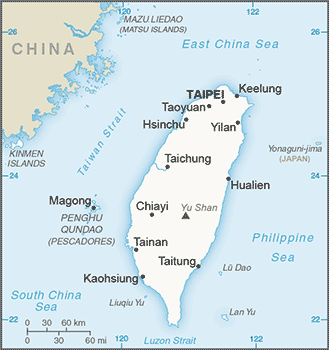 In 1622 the Dutch built a fort and founded a colony on Formosa (Taiwan), and in 1642 they drove off a Spanish attempt at colonization. The Dutch used the island as a base for trade with China and Japan, and a few Chinese immigrated from mainland China to Taiwan.
In 1622 the Dutch built a fort and founded a colony on Formosa (Taiwan), and in 1642 they drove off a Spanish attempt at colonization. The Dutch used the island as a base for trade with China and Japan, and a few Chinese immigrated from mainland China to Taiwan.
In 1662 representatives of the Ming dynasty of China defeated the Dutch, but in 1684 the Ming were defeated by the Qing dynasty and Taiwan came under the control of the Qing empire.
In 1894 Japan invaded China, and the First Sino-Japanese War began. It ended in 1895, with the defeat of China. Japan took control of Taiwan. During WW II Japan used Taiwan as a base for the invasion of Southeast Asia and the Pacific.
At the end of WW II control of Taiwan went to the Nationalist Government of China (the Kuomintag, under Generalissimo Chiang Kai-shek)When the KMT lost the Chinese Civil War in 1949 they fled to Taiwan and Chiang Kai-shek declared a sate of martial law. Chiang kai-shek died in 1975, and the government of Taiwan instituted democratic reforms. A Democratic Progressive Party was formed in 1986, and the first direct presidential election was held in 1996. In the elections of 2004 the KMT was voted out of office, and the DPP won the vote.
Hong Kong
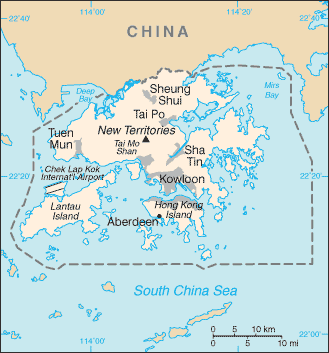
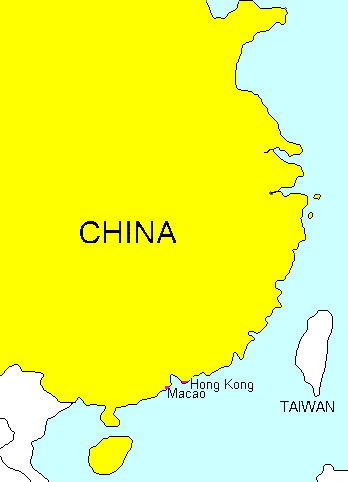 In 1839 China lost the First Opium War and was forced to cede Hong Kong to Britain and agree to import opium in a bad trade deal. In 1860 China lost the Second Opium War and had to grant more land to Britain, then in 1898 Britain obtained a 99-year lease on more territory, with the promise that the whole of Hong Kong would be returned to China when the lease ended in 1997.
In 1839 China lost the First Opium War and was forced to cede Hong Kong to Britain and agree to import opium in a bad trade deal. In 1860 China lost the Second Opium War and had to grant more land to Britain, then in 1898 Britain obtained a 99-year lease on more territory, with the promise that the whole of Hong Kong would be returned to China when the lease ended in 1997.
When Japan joined WW II the Japanese bombed Hong Kong and then invaded it. The British were killed or imprisoned, and half the population fled to mainland China. Hong Kong became a Japanese colony until the end of WW II.
When Japan surrendered in 1945 the British took control of Hong Kong again, and remained there until 1997.
In 1985 Britain and the communist People's Republic of China issued a Joint Declaration, that Britain would relinquish Hong Kong to the PRC in 1997, and the PRC promised that Hong Kong would be a Special Administrative Region and retain its capitalist system and its way of life unchanged for the next 50 years. The change-over did take place in 1997 as scheduled.
Macao
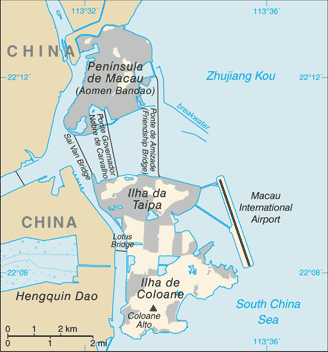
 In 1557 Portugal leased the port of Macao from Ming China and established the first European settlement in the Far East. Macao was primarily a trading post, though in 1576 Pope Gregory XIII established the Roman Catholic diocese of Macao, and in 1582 Matteo Ricci arrived in Macao to learn Chinese before venturing further inland as a missionary. In 1887 the Quing government of China signed a treaty which gave Portugal the right of perpetual occupation and government of Macao. Even when the Quing dynasty was overthrown by the Kuomintag (Chinese Nationalists) in 1928, a new treaty was signed, with similar provisions. Even during WW II the Japanese respected the neutrality of Portugal and did not invade Macao, though they did send Japanese 'advisors' to 'protect' the region, under the threat of military occupation. During WW II the USA bombed Macao several times to prevent the trade of aviation fuel between Macao and Japan.
In 1557 Portugal leased the port of Macao from Ming China and established the first European settlement in the Far East. Macao was primarily a trading post, though in 1576 Pope Gregory XIII established the Roman Catholic diocese of Macao, and in 1582 Matteo Ricci arrived in Macao to learn Chinese before venturing further inland as a missionary. In 1887 the Quing government of China signed a treaty which gave Portugal the right of perpetual occupation and government of Macao. Even when the Quing dynasty was overthrown by the Kuomintag (Chinese Nationalists) in 1928, a new treaty was signed, with similar provisions. Even during WW II the Japanese respected the neutrality of Portugal and did not invade Macao, though they did send Japanese 'advisors' to 'protect' the region, under the threat of military occupation. During WW II the USA bombed Macao several times to prevent the trade of aviation fuel between Macao and Japan.
In 1999 Macao was returned to China, though it will remain as a special administrative region until 2049.
Copyright © 1999 Shirley J. Rollinson, all Rights Reserved
